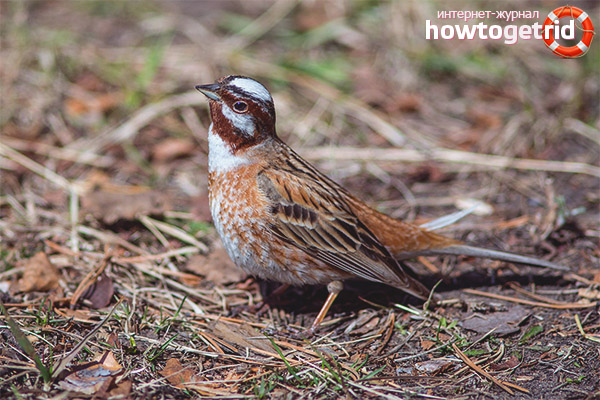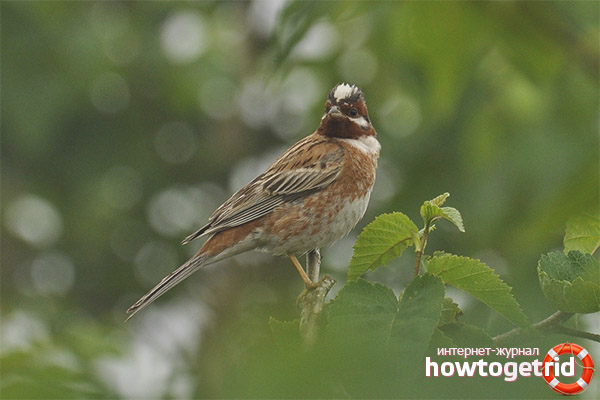The content of the article
White-cap oatmeal - a very small bird, the size of a sparrow. It belongs to the order of passerines, to the oatmeal family.
In other oatmeal, first of all, there is no white cap on the head, by which you can recognize males directly. In females, the hat is sandy white.
Body length and weight of these birds:
- males 17.5 - 19 cm, weight - up to 30 g .;
- in females 16.5 - 18 cm, weight - up to 28 gr.
Appearance
The color of the male, first of all, is distinguished by a white plumage on the head, resembling a small white hat. Sometimes in this place narrow and rather rare leaves of feathers are noticeable. On the sides of the cap are stripes of black color or with the presence of a chestnut hue, the same color and forehead. Chestnut-colored eyebrows, throat. Eye rims and strips located behind the eyes also have the same color. But the strip passing under the eye, the goiter and spots on both sides of the cheeks are white. Small dark beak. The closer to the beak, the slightly lighter.
The wings of the male are 8.8–9.6 cm, and of the females are 8.1–9.4 cm. The apex of the wing is the first three, almost the same, primary wing. But the fourth is already shorter than the previous ones, and the subsequent ones are even shorter. In the caudal part, the extreme ones are longer than the average ones; therefore, a noticeable notch is obtained.
The color of the steering is usually brown. But the two extremes have a difference in that there are large spots of white color, and to the extreme feather they occupy a large part. The legs of the birds are brown.
The female as a whole differs little from the male. The difference is that on the head the white color is not so much developed, the feathers are wide, have an olive-gray color, therefore they almost completely hide the white color, and the wide mottles are located more often. The back is not so bright, the streaks are also black, but less pronounced. There is also a chestnut color on the throat, but it has a slightly sandy tint. With the same sandy but buffy color, goiter and sides, belly - with a grayish coating.
Young oatmeal is similar to each other, resembling adult females. But there are significant differences from parents - this is the underdevelopment of white color on the head or it is only slightly noticeable. Those stripes that border the white spot, in contrast to the black ones that are present in the formed birds, are brown in color. Dorsal streaks quite dull. There is still no solid ocher or chestnut tone on the throat, chest, chin and sides. But young birds have a very developed spotting, which has a dark brown shade on the throat, and then it gradually changes to ocher-brown. The goiter still has a very small white speck with a small amount of dark speckles. If the winter season begins, a brownish-olive color appears on the head and back, in summer these parts acquire a brownish tint. The belly looks dirty white. Legs and beak with a light brown shade.
White-cap bunting and her love of open space
This type of oatmeal lives mainly in Asia, in Siberia; it is found in separate groups in China. Distributed in the taiga and forest-steppe, it can also be found low in the mountains. But nevertheless, the most favorite habitats are the bright sunny edges of a mixed or pine forest, clearings and clearings, a forest or field, clearings and even the outskirts of a forest park.
This is a migratory species of birds, but some of them prefer to stay at home for the winter. Therefore, autumn flights are characterized by low intensity and end already in the first part of October. They spend cold time near the Mediterranean or in Western Europe. They begin to fly back in March; at the end of April, the arrival is fully completed. Those who remain for the winter usually spend time in harvested fields, in settlements, settling on the outskirts, in vegetable gardens.
Returning to their homeland, they choose places to stay, such as trees and bushes, so that there is an open and sunny space, most often along the roads.
Food
It holds, except for the spring period - at the time when couples are created, in flocks. Often, teaming up with sparrows or other small birds, they all go out in search of food. Together with insects, they eat seeds of many plants with pleasure. White-cap oatmeal eats on the ground.
Voice and singing
Males sing on top of a tree or bush. Their voice is sonorous, singing resembles the sounds of "tin-tini", in the end the sounds gradually become quieter. A scream is soft sounds, similar to a cyc-cyc.
In the open space of the enemy they notice quickly, and immediately fly away.
Procreation
Typically, 4 to 6 eggs can be found in a nest. They have shades from dirty white to gray-blue, covered with meandering dark - brown or brown - patterns, lines and blotches. The female is usually located in the nest, and the male can occasionally change it. If the nest was disturbed, the birds will leave it forever.
After 12-14 days, chicks appear, which are fed by both parents. In babies, the dorsal part is covered with plumage of a brownish-olive color. The streaks are only brownish-dark; the chestnut color is completely absent. Dark brown spots are very developed on the brownish-olive abdomen, starting from the throat to the undertail. But in the middle of the abdomen, the spotting is small.
Video: white-cap oatmeal (Emberiza leucocephala)











Submit